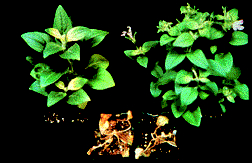plant form by a single nucleotide was introduced into plants via Ti plasmids; the bacterial enzyme in these plants is not inhibited by glyphosate.
These advances are of great interest to farmers because a crop resistant to Roundup would never have to be weeded if the field were simply treated with the herbicide. Because Roundup is a broad-spectrum herbicide, farmers would no longer need to employ a variety of different herbicides, most of which kill only a few kinds of weeds. Furthermore, glyphosate breaks down readily in the environment, unlike many other herbicides commonly used in agriculture. A plasmid is actively being sought for the introduction of the EPSP synthetase gene into cereal plants, making them also glyphosate-resistant.
Nitrogen Fixation
A long-range goal of agricultural genetic engineering is to introduce the genes that allow soybeans and other legume plants to “fix” nitrogen into key crop plants. These so-called nif genes are found in certain symbiotic root-colonizing bacteria. Living in the root nodules of legumes, these bacteria break the powerful triple bond of atmospheric nitrogen gas, converting N2 into NH3 (ammonia). The plants then use the ammonia to make amino acids and other nitrogen-containing molecules. Other plants lack these bacteria and cannot fix nitrogen, so they must obtain their nitrogen from the soil. Farmland where these crops are grown soon becomes depleted of nitrogen, unless nitrogenous fertilizers are applied. Worldwide, farmers applied over 60 million metric tons of such fertilizers in 1987, an expensive undertaking. Farming costs would be much lower if major crops like wheat and corn could be engineered to carry out biological nitrogen fixation. However, introducing the nitrogen-fixing genes from bacteria into plants has proved difficult because these genes do not seem to function properly in eukaryotic cells. Researchers are actively experimenting with other species of nitrogen-fixing bacteria whose genes might function better in plant cells.
Insect Resistance
Many commercially important plants are attacked by insects, and the traditional defense against such attacks is to apply insecticides. Over 40% of the chemical insecticides used today are targeted against boll weevils, bollworms, and other insects that eat cotton plants. Genetic engineers are now attempting to produce plants that are resistant to insect pests, removing the need to use many externally applied insecticides.
The approach is to insert into crop plants genes encoding proteins that are harmful to the insects that feed on the plants but harmless to other organisms. One such insecticidal protein has been identified in Bacillus thuringiensis, a soil bacterium. When the  Figure 20
Figure 20
Genetically engineered herbicide resistance. All four of these petunia plants were exposed to equal doses of the herbicide Roundup. The two on top were genetically engineered to be resistant to glyphosate, the active ingredient of Roundup, while the two on the bottom were not. tomato hornworm caterpillar ingests this protein, enzymes in the caterpillar’s stomach convert it into an insect-specific toxin, causing paralysis and death. Because these enzymes are not found in other animals, the protein is harmless to them. Using the Ti plasmid, scientists have transferred the gene encoding this protein into tomato and tobacco plants. They have found that these transgenic plants are indeed protected from attack by the insects that would normally feed on them. In 1995, the EPA approved altered forms of potato, cotton, and corn. The genetically altered potato can kill the Colorado potato beetle, a common pest. The altered cotton is resistant to cotton bollworm, budworm, and pink bollworm. The corn has been altered to resist the European corn borer and other mothlike insects.
Monsanto scientists screening natural compounds extracted from plant and soil samples have recently isolated a new insect-killing compound from a fungus, the enzyme cholesterol oxidase. Apparently, the enzyme disrupts membranes in the insect gut. The fungus gene, called the Bollgard gene after its discoverer, has been successfully inserted into a variety of crops. It kills a wide range of insects, including the cotton boll weevil and the Colorado potato beetle, both serious agricultural pests. Field tests began in 1996.
Some insect pests attack plant roots, and B. thuringiensis is being employed to counter that threat as well. This bacterium does not normally colonize plant roots, so biologists have introduced the B. thuringiensis insecticidal protein gene into root-colonizing bacteria, especially strains of Pseudomonas. Field testing of this promising procedure has been approved by the Environmental Protection Agency.